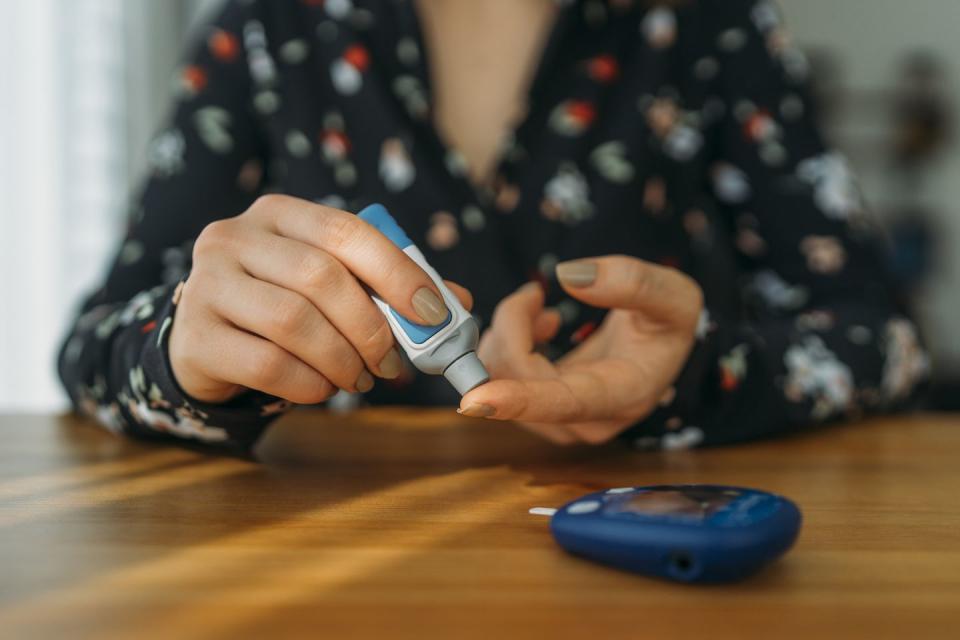Endocrinologists Explain the Different Types of Diabetes, and the Causes and Treatments for Each

The pancreas is a vital organ that has many tasks—one of the most important being to help the body process insulin. When this goes awry, it can often be an indicator of diabetes. But there are different types of diabetes, and each one is unique. Ahead, we’re breaking down the most common (and a few less common) types of diabetes and exploring the various symptoms and treatments for each.
What is diabetes?
While there are different types of diabetes, they all stem from the body’s inability to regulate blood sugar. When we eat food, the body turns it into glucose (sugar) which provides us with the energy we need to function. However, insulin is necessary to shuttle that glucose from our blood to other parts of our body. When a person has diabetes, either the beta cells in their pancreas produce no insulin (type 1 diabetes) or the beta cells do not make enough insulin to overcome the fact that the cells in their muscles, fat, and liver don’t respond to insulin properly (a situation called insulin resistance, which is found in type 2 diabetes). The result? Too much sugar remains in the bloodstream, which over time can have dangerous consequences that include nerve damage, vision loss, and kidney failure. But in order to figure out the best treatment plan, you need to know what type of diabetes you’re dealing with.
Type 1 Diabetes
“Type 1 diabetes is an absolute deficiency of insulin—your body is not making insulin,” says Kathleen Wyne, M.D., Ph.D., a professor in the Division of Endocrinology and Metabolism at The Ohio State University Wexner Medical Center. “The majority of type 1 is due to an autoimmune process where your immune system is attacking your pancreas, and that's what leads to the insulin deficiency.” Research shows that type 1 diabetes makes up just 5.6% of all diabetes cases among U.S. adults.
Causes
“About 50% of the risk of type 1 is caused by genetic causes and the rest is environmental,” says Maria Jose Redondo, M.D., Ph.D., M.P.H., a professor of pediatrics in diabetes and endocrinology at Baylor College of Medicine and Texas Children’s Hospital. “In terms of the genes, it’s polygenic so there are many, many genes contributing to that.” She says some scientists from the University of Exeter have created a scoring tool to help physicians like herself determine a patient’s risk of developing type 1 diabetes. Diagnosing the condition before it is severe is crucial for pinpointing the best prevention and treatment strategies. Researchers are also looking into the environmental factors that contribute to type 1 diabetes. “Most of the evidence today points toward enteroviruses,” says Dr. Redondo. “Basically, a chronic low-grade enterovirus infection that persists in the pancreas and either makes the beta cells more sensitive to the autoimmune attack or triggers an autoimmune attack.”
Symptoms
Here are some type 1 diabetes red flags, according to the Mayo Clinic:
Increased thirst and urination (including bed-wetting in kids)
Extreme hunger
Unintended weight loss
Mood changes
Fatigue and weakness
Blurred vision
Treatment
“If you have type 1 diabetes, you need to be on insulin,” says Dr. Wyne. “If you don't have insulin or you don't have enough insulin, you could develop diabetic ketoacidosis, and you can actually die from that.” Insulin is injected based on an individual’s needs, but doses may be lower in the beginning and increase over time, according to Dr. Wyne. “In the people diagnosed over about age 40, it seems to be a slower disease and so we often treat them a little bit differently,” she adds. “We might give them some of the type 2 medicines in addition to their insulin at first, but we're still going to do an insulin-based regimen.” While you might hear people with type 2 diabetes talk about cutting back on their carbohydrate intake, that’s not typically advised for people with type 1 diabetes. “We do ask them to eat heart-healthy, but what we do nowadays is we teach them to match their insulin to their food,” says Dr. Wyne.

Type 2 Diabetes
You’ve probably heard of type 2 diabetes more often than any other type. “Type 2 is a relative deficiency of insulin,” says Dr. Wyne. “Your sugar goes up because your body is not making enough insulin for what it needs. Most people with type 2 diabetes are actually resistant to insulin so they need circulating insulin at levels that are higher than someone who either is not resistant or does not have a family history of diabetes.” Research shows that type 2 diabetes makes up a whopping 91.2% of all diabetes cases among U.S. adults. Additionally, the CDC estimates that 88 million adults in the U.S. have prediabetes. “Prediabetes is when the glucose has started to rise, but does not yet meet criteria for type 2 diabetes,” says Dr. Wyne. “The key is that this is supposed to be a warning sign that glucose is starting to rise, but the process can be (temporarily) reversed with diet, exercise, or weight loss.”
Causes
Scientists aren’t sure of the exact mechanism that causes type 2 diabetes, but a family history of the condition is an important predictor. It seems that the genetics and/or lifestyle that a family shares may make its members more resistant to insulin from the start or hinder their ability to produce enough insulin. Being inactive, overweight, or African American, Latino American, American Indian, or Alaska Native is also associated with an increased risk of developing type 2 diabetes, according to the CDC.
Symptoms
These are the signs of type 2 diabetes that you should watch out for, according to the Cleveland Clinic:
Increased thirst and urination
Extreme hunger
Unintended weight loss
Fatigue
Blurred vision
Slow healing of wounds
Tingling or numbness in hands or feet
Treatment
The first step in treatment for type 2 diabetes is usually an oral diabetes medication like metformin along with changes in diet and exercise. “We’re using the pills to try to get it so that the person responds better to their insulin and maybe makes a little bit more insulin,” says Dr. Wyne. The goal is to help keep blood sugar balanced for as long as possible without insulin injections, but most people end up needing insulin as part of their therapy at some point. “The most important predictor of long-term control on a non-insulin based regimen is the amount of weight lost at the time of diagnosis and the ability to keep it off,” says Dr. Wyne. That said, “it's important that people know it's not their fault that they need insulin,” she adds. “It's not that they didn't take care of themselves. It's not because they failed. You do not get addicted to insulin. Insulin is a hormone that your body makes that you need to live.”
Gestational Diabetes
Although research shows an increasing number of women are being diagnosed with diabetes during pregnancy, Dr. Wyne says physicians are shying away from using the term "gestational" to describe all of those cases. Traditionally, formal testing of gestational diabetes is done at the start of the third trimester of pregnancy when blood sugars usually rise. However, many cases of diabetes are also diagnosed in the first and second trimesters. According to Dr. Wyne, those ones tend to be pre-existing cases that either weren’t identified prior to pregnancy because a woman didn't regularly see a physician or were on the cusp before pregnancy but didn’t meet the criteria for full-blown diabetes. Technically, those instances of diabetes are not considered to be "gestational." Because diabetes can pose risks during pregnancy, current guidelines from The American College of Obstetricians and Gynecologists recommend women who have risk factors for diabetes are screened for it at their first natal visit.
Causes
According to the American Diabetes Association, a woman's body may not be able to produce all the insulin it needs during pregnancy or hormones created by the placenta may hinder the body’s ability to efficiently use the insulin it makes. Essentially, pregnancy is like a stress test for your pancreas and being diagnosed with gestational diabetes is a warning sign that you and your doctor should be on the lookout for type 2 diabetes, adds Dr. Wyne. In fact, half of all women that have gestational diabetes will go on to be diagnosed with type 2 diabetes, according to the CDC. “Glucose always returns to normal immediately after delivery and it tends to stay normal for 12 to 72 hours,” says Dr. Wyne. “The key is whether the glucose then remains normal. Losing all of the pregnancy weight and staying physically active can have a dramatic impact on the number of years until glucose again rises to meet criteria for type 2 diabetes.”
Treatment
In most cases, gestational diabetes is treated by monitoring glucose levels and making appropriate changes in diet and exercise, but medications and insulin may be prescribed if these changes aren’t enough to stabilize blood glucose levels.

Less common types of diabetes
The types of diabetes mentioned below affect far fewer people than the conditions outlined above, but they are just as important to know about.
Monogenic
Under the umbrella of monogenic diabetes syndromes there are two main categories: neonatal diabetes mellitus and maturity-onset diabetes of the young (MODY). Neonatal diabetes appears before a baby turns a year old while MODY emerges in adolescence or young adulthood. “In those diabetes, there's a single [genetic] mutation that causes the disease,” says Dr. Redondo.
She says researchers have identified some genes that can be affected, but there are many more potential variants to be discovered. “It is really important because in some of those, the molecular defect is known and you can treat it with a specific treatment for that,” explains Dr. Redondo. “For example, people with a particular type of MODY used to be treated with insulin, thinking that they have type 1 diabetes or type 2 diabetes, but since this has been discovered, the molecular mechanism was known and then people realized that they respond better with sulfonylurea which is a type of oral medication.” If you’ve been told your diabetes is atypical (say, you were diagnosed with type 2 but exhibit no risk factors), Dr. Redondo recommends checking out the Rare and Atypical Diabetes Network (which she is a part of) and signing up to see if you’re a fit for any research studies. The organization is trying to define lesser-known types of diabetes, advance testing, and identify proper treatments.
Chemical-induced
A variety of medications, from corticosteroids to beta blockers can trigger insulin resistance, insulin deficiency, or both. If you recently started taking a new medicine and notice any of the diabetes-related symptoms listed above, let your physician know.
Cystic fibrosis-related
“This type is relatively new in the sense that in the past, sadly, children with cystic fibrosis would die before reaching their 20s,” says Dr. Redondo. “Today, thank goodness, we can help them live past that age, but other complications can develop such as diabetes.” According to the Cystic Fibrosis Foundation, the sticky mucus that’s associated with cystic fibrosis can damage the pancreas to the point that it no longer produces enough insulin.
You Might Also Like

